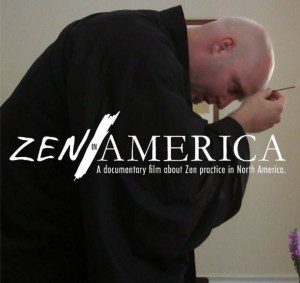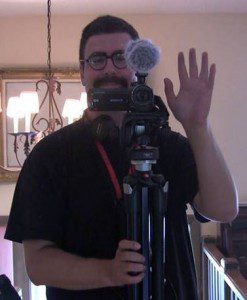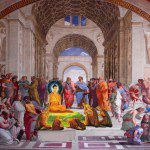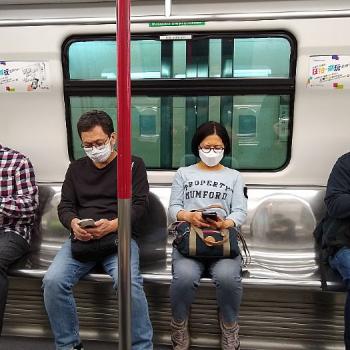Adam Kō Shin Tebbe is creating the documentary film Zen in America. My friend and fellow Patheos Blogger Danny Fisher discussed the documentary in a recent post at the start of Adam’s fundraising campaign on Kickstarter. Now over 90% funded, I recently took the opportunity to ask some questions of my own. Have a look at Danny and Adam’s conversation (here) to read more about Adam’s work, past and future.
And with that, we’ll dive in…
JW: So you are making a documentary about Zen in America. First some methodological questions: What is Zen? What is America? Talk to me about the physical/geographical and other borders to this project.
Zen is a Mahayana Buddhist tradition that began in China as a distinct school sometime in the 6th century, spreading later to Vietnam, Korea and Japan. As you and your readers probably know, the term comes from the Sanskrit word dhyāna, which basically means meditation. So Zen Buddhism could be described as a tradition that places a great emphasis on meditation.
For the purposes of my film “Zen in America”, we’ll be focusing on North America – which means I’ll be filming in the United States, Canada, and Mexico. What we’re seeing today over here is a transformation of the tradition rather than a mere transplantation, inherited from early pioneers who came over from Japan, Korea, Vietnam and China. Traditionally we mark the World’s Parliament of Religions of 1893 as Zen’s first major entryway in the United States, where the Rinzai priest Soyen Shaku arrived as a representative of the tradition. Interestingly, while today Soto Zen and Korean Zen derivatives are by far the more dominant paths, the earliest teachers to come over here were from the Rinzai school – people like Soyen Shaku, D.T. Suzuki, Nyogen Senzaki and Sokei-an. In Canada you have Samu Sunim and his lineage, as well as several affiliate groups of sanghas that began in the United States. As far as Mexico is concerned, I’m as interested as anyone else to learn more about its history and what is going on today down there.
Put simply, I’ve limited this series to North America for practical reasons. There’s quite a lot to explore as it is by limiting it to the three countries and I’ll have more than enough to tackle. I plan to cover all of the main schools and lineages such as Vietnamese Zen (which includes Thich thien-An and Thich Nhat Hanh), the Rinzai school (which includes Sokei-an, Joshu Sasaki, Eido Shimano, Shodo Harada and Omori Sogen), the Soto school (which includes Shunryu Suzuki, Soyu Matsuoka, Kobun Chino, Taizan Maezumi, Jiyu Kennett, Dainin Katagiri and some of Deshimaru’s American groups), the Harada-Yasutani lineage and its derived lineages, from Aitken to Kapleau and many others, and Korean Zen derivatives, including Seung Sahn and Samu Sunim. There’s a lot of complexity in there and I’m condensing it all quite a bit for the purposes of this interview, as some teachers like Maezumi had transmission in Rinzai, Soto and Harada-Yasutani.
I don’t plan to include “self-proclaimed” teachers in the film series. That’s not to say they aren’t of value or worth taking a look at. It’s a simple matter of wanting to focus on lineages where the lines of succession are clear enough, though the topic of independent teachers will surely come up when we’re discussing teachers like Philip Kapleau in the film.
JW: You mentioned to Danny that you ordained as a Buddhist this year. What does that mean, exactly?
That’s a good question. I took formal jukai in July and received my rakusu, taking the Sixteen Bodhisattva Precepts during my ceremony. From what my preceptor Myoan Grace Schireson has told me, the first portion of my dharma name (Butsu Mon, or Buddha Gate) is a challenge of sorts – will I endeavor to keep the gate open or closed? The second portion of my name (Kō Shin, or Shining Heart) is supposed represent how others might view me. They’re both a challenge and I’m trying (and sometimes I fail). But it is somehow a bit more serious to me now, like a commitment I had made to myself and others to follow the Buddhist path.
JW: Will the documentary itself have a sort of ‘Zen flavor’ – if there is such a thing? That is, do you plan to consciously impart teachings upon the viewer in some way?
That’s another good question. The teachings will be presented, though not by me – but by those I’ll be interviewing. I’ll then do some consulting in later stages of post-production with various teachers in order to best structure chapters and parts of the series. So it’s going to be a largely interview driven film with a lot of visuals showing viewers just what we’re doing (in the formal sense). In that way, I don’t think we could even escape it having a Zen flavor, as you call it. The idea behind this is very mahasangha in spirit, and so it’s not going to be following just one person around for too long (except when necessary, such as the historical portions). I just want people to walk away from the series feeling like we did the tradition some justice by showing its diversity.
JW: What filmmakers/documentarians influence or inspire you as a budding documentarian?
I actually really liked Mitch Schultz’s documentary “DMT: The Spirit Molecule” quite a bit, and it’s available for people to check out on YouTube right now, even. I felt that film conveyed the subject matter truthfully while also appealing to an audience that went beyond those who are solely interested in DMT. So I kind of look to that film and watch to see how Mitch did it, which will come further along in the process when I’m editing. I mention this film because they really dove deeply in to one subject and covered it well by gathering the voices of so many people familiar with it. That’s definitely what I plan to do in the film. I’m also really excited to see Adam Eurich’s film “Seeking Heartwood” when it comes out, as it’s a little bit like what I’m doing – though Adam tells me it may have a more personal story aspect to it.
JW: You also mentioned in your interview with Danny that you will cover some of the controversies that have arisen in certain schools of Zen in America. Do you have a sense of how much time you will devote to this topic?
I will. How much is sort of an open question, though it certainly won’t be the primary focus. You can’t tell the story of Zen in North America without discussing it some, however. It’s not really possible to do so, as most of the lines have been touched by some of the problems around teacher misconduct at times. Some lines will have this issue discussed in the film more than others will, and that’s because in some cases this and other issues have been a more prominent. So it’s going to be discussed where appropriate. I really can’t give any estimate of how much time will be devoted to it right now, but I can say it won’t be the main focus of the film. I see it more as a part of the overall story, layered with lots of characters and personalities and complexity. Where the issue does need discussing, I’ll be talking to a swath of individuals and let the audience decide what they feel about it all. In all I anticipate the entire series will be in 5 or 6 parts, starting with the history.
JW: I see that you’re around 90% to your total in fundraising. But of course you only get the money if you’re 100% funded. How important is this round of crowd-funding and how will additional funds help in the project?
Assuming we’ll hit the $10,000 mark, which it looks like we are going to do, I’ll be adding info about what Kickstarter calls a “stretch goal.” Basically, as I’ve stated from the beginning in the project, my minimum is a conservative one and I set it lower rather than higher as I figured $10,000 would at least get me out and filming for the next year or more. However, I have anticipated travel expenses for this entire journey over the coming years will be more realistically in the $20,000 to $30,000 area. Flights, rental cars, gas, food – it all adds up quite a bit. I won’t be staying in hotels as a practice but for the rarest of emergencies, and if I do I’ll be sure it’s a motel.
So, basically, the $10,000 will allow me to start filming, and anything beyond that will allow me to get to more and more places. I may even have to revisit funding again in the distant future again, depending on how this fundraising effort goes. I figure if I have to go that route, I’ll have met a lot of new people and made more personal connections, which goes a long way when you’re looking to get a film backed. But we’ll see. I’m hoping to raise anything $10,000 or above.
JW: You plan on working on this for three years. Will you give us some updates and sneak-peaks as you go along?
Definitely. Some have already expressed a concern to me that the trailer is very white! A point I was well aware of when putting it together. That’s because I had a limited amount of footage and interviews to use for this first push, to get the ball rolling. There’s going to be a lot more diversity in the final film, rest assured. So, I’ll likely be updating the trailer a bit as I get further in to the filming process.
I’ll also be making available dharma talks I might capture on film during my stays as extras, as I will never be able to use full length talks in the final film. I’ll also blog regularly at the website and Facebook to let everyone know where I am and what I’m currently filming.
I really enjoyed your questions of me today, Justin. Thank you.
 Visit the official Zen in America Kickstater campaign page here.
Visit the official Zen in America Kickstater campaign page here.
Zen in America official website: http://zeninamerica.com/
On Facebook: https://www.facebook.com/pages/Zen-in-America-a-documentary/
On Twitter: https://twitter.com/ZenInAmerica
Our YouTube channel: http://www.youtube.com/channel/UCr4SE7s9aVNFpJ-wmNlBNMA













